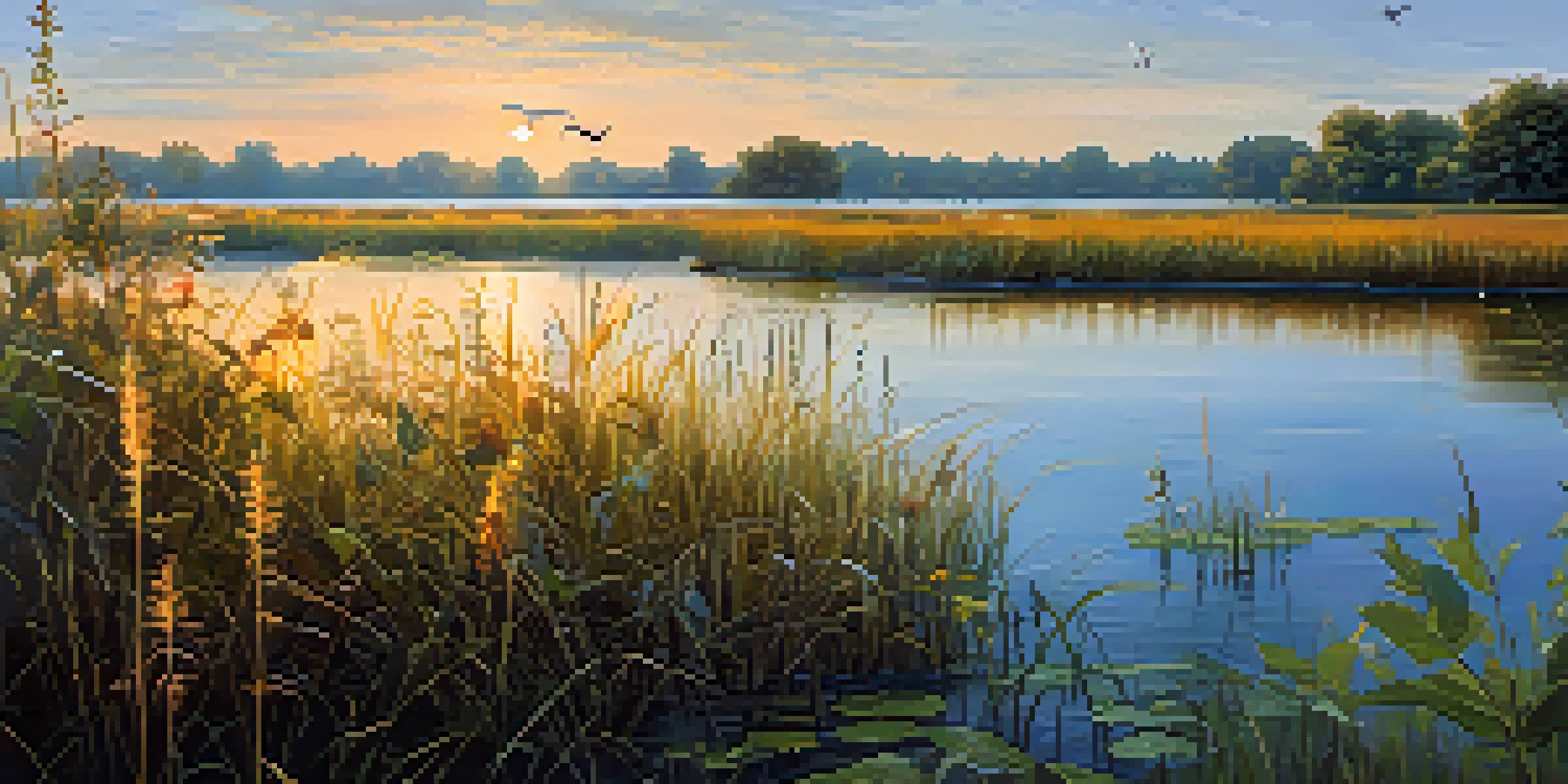Biodiversity in Illinois: Protecting Endangered Species

Understanding Biodiversity and Its Importance
Biodiversity refers to the variety of life in a specific ecosystem, including the different species of plants, animals, and microorganisms. In Illinois, this diversity is crucial not only for maintaining ecological balance but also for supporting human life. Healthy ecosystems provide services such as clean air, water filtration, and pollination, which are vital for agriculture and our overall well-being.
In every walk with nature one receives far more than he seeks.
The state of Illinois is home to a rich tapestry of ecosystems, ranging from wetlands and prairies to forests and rivers. Each of these habitats plays a unique role in supporting various species, many of which are native to the region. Protecting this biodiversity is essential, as it enhances resilience against environmental changes and helps sustain the natural beauty that residents and visitors cherish.
Moreover, biodiversity contributes significantly to the economy, particularly through tourism and recreation. Many people flock to Illinois to experience its natural wonders, which illustrates the interconnectedness of nature and human activity. Encouraging the protection of biodiversity ultimately benefits both the environment and the people who depend on it.
Current State of Endangered Species in Illinois
Illinois is home to numerous endangered species, each facing threats from habitat loss, pollution, and climate change. For instance, the Illinois chorus frog and the eastern prairie fringed orchid are just two examples of species that are struggling to survive in a rapidly changing environment. These species not only represent the unique biodiversity of the region but are also indicators of the health of their ecosystems.

The Illinois Department of Natural Resources (IDNR) monitors these species closely and has developed conservation plans aimed at addressing the specific challenges they face. Public awareness and advocacy play a crucial role in these efforts, as community involvement can significantly impact conservation outcomes. Many organizations and volunteers work tirelessly to restore habitats and protect these vulnerable species.
Biodiversity's Vital Role in Illinois
Biodiversity is essential for ecological balance, human well-being, and economic benefits in Illinois.
Understanding the plight of endangered species is vital for fostering a sense of stewardship among residents. When people recognize the importance of these species, they are more likely to support conservation initiatives and participate in local efforts to protect their natural habitats. Raising awareness about endangered species is a key step toward ensuring their survival for future generations.
Key Threats to Biodiversity in Illinois
Several significant threats pose challenges to biodiversity in Illinois, with habitat destruction being at the forefront. Urban development, agriculture, and industrial activities often encroach upon natural habitats, fragmenting ecosystems and isolating wildlife populations. This disruption can lead to decreased genetic diversity, making species more vulnerable to disease and environmental stresses.
The Earth does not belong to us: we belong to the Earth.
Pollution is another major threat, impacting both terrestrial and aquatic ecosystems. Runoff from agricultural fields, urban areas, and industrial sites can introduce harmful chemicals into the environment, degrading water quality and affecting wildlife health. Additionally, invasive species can outcompete native species for resources, leading to declines in local biodiversity.
Climate change further exacerbates these threats, altering weather patterns and affecting wildlife habitats. Species that are unable to adapt to these changes face increased risk of extinction. By understanding these threats, we can better strategize ways to mitigate their impact and promote a healthier, more resilient environment.
Conservation Efforts in Illinois
Illinois has made significant strides in conservation efforts aimed at protecting its endangered species and their habitats. Various government agencies, non-profit organizations, and local communities collaborate to implement conservation programs. These initiatives often focus on habitat restoration, species monitoring, and public education to raise awareness of biodiversity issues.
One successful example is the establishment of protected areas such as state parks and nature reserves, which serve as sanctuaries for endangered species. These designated areas provide safe havens where wildlife can thrive without the pressures of urban development. Furthermore, conservationists engage in reforestation and wetland restoration projects to improve habitat quality and connectivity.
Threats to Endangered Species
Habitat destruction, pollution, and climate change pose significant risks to endangered species in Illinois.
Public engagement is also a cornerstone of these conservation efforts. Community members are encouraged to participate in volunteer programs, citizen science projects, and local advocacy. By fostering a culture of conservation, Illinois aims to inspire residents to take an active role in protecting the natural world around them.
The Role of Community in Biodiversity Protection
Community involvement is vital in the fight to protect biodiversity in Illinois. Local residents can have a profound impact by participating in conservation initiatives and advocating for policies that protect endangered species. Whether it's volunteering for local clean-up efforts or joining citizen science projects, every individual can contribute to the greater good.
Educating the community about the importance of biodiversity and the challenges faced by endangered species fosters a sense of responsibility. Schools, community organizations, and local governments can work together to promote awareness through workshops, events, and educational programs. This grassroots approach can lead to significant change as more people become engaged in conservation efforts.
Moreover, communities can collaborate with scientists and conservationists to monitor local wildlife populations and habitats. This partnership not only aids in data collection but also empowers residents to take ownership of their environment. By building a strong community network focused on biodiversity, Illinois can better protect its natural heritage for future generations.
Future Directions for Biodiversity in Illinois
Looking ahead, the future of biodiversity in Illinois will depend on continued commitment to conservation and innovative strategies to combat emerging threats. As climate change continues to impact ecosystems, adaptive management practices will be essential. This may involve re-evaluating conservation priorities and implementing new strategies tailored to shifting environmental conditions.
Collaboration between government agencies, non-profits, and local communities will be crucial in addressing the complexities of biodiversity conservation. Integrating scientific research with community knowledge can lead to more effective solutions and help ensure that conservation efforts are both impactful and sustainable. The goal is to create resilient ecosystems that can withstand future challenges.
Community Action is Crucial
Community involvement and education are key to successful biodiversity conservation and protecting endangered species.
Ultimately, fostering a culture of conservation and stewardship is key to securing a healthier future for Illinois' biodiversity. As more individuals recognize the intrinsic value of nature and the interconnectedness of all living things, the state can work towards a more sustainable relationship with its environment. Together, we can build a legacy of conservation that benefits both people and wildlife.
How You Can Help Protect Endangered Species
Every individual has the power to make a difference in the protection of endangered species in Illinois. Simple actions, such as reducing waste, conserving water, and supporting sustainable practices, can collectively contribute to a healthier environment. By making conscious choices in our daily lives, we can help minimize our ecological footprint and protect natural habitats.
Getting involved in local conservation organizations is another impactful way to contribute. Many groups focus on habitat restoration, wildlife monitoring, and educational outreach. By volunteering your time and skills, you can play a direct role in efforts to safeguard endangered species and their ecosystems.

Finally, advocating for policies that promote conservation at local, state, and national levels can amplify your impact. Engaging with lawmakers, supporting conservation initiatives, and spreading awareness about biodiversity issues can drive meaningful change. Every action counts, and together, we can create a brighter future for Illinois' endangered species.